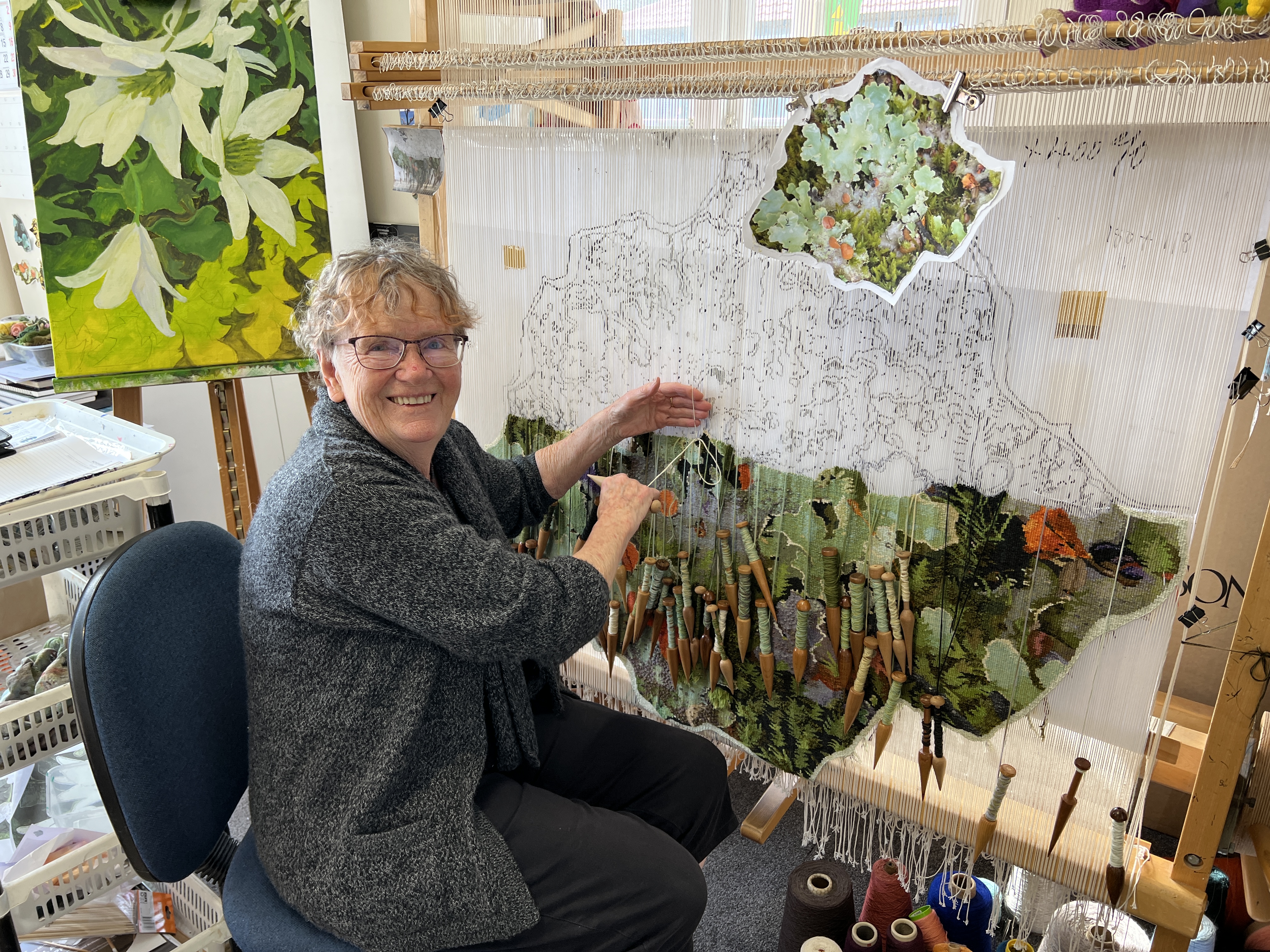|
Salasaca
Salasaca is a community and an indigenous people located in the Tungurahua Province in the center of Ecuador, halfway along the road from Ambato to Baños. The Salasaca speak Spanish and their traditional language of Quichua. Their main economic activities are agriculture, livestock-raising, and handcrafts. A market in the central plaza of Salasaca is called "Plaza of the Arts." Local craftsmanship includes items such as tapestries, which are woven by hand on looms of very ancient technology. Many of the designs depict different aspects of their lives. Pigments are often derived from the female cochineal of the Dactylopius family which are crushed to make red colors. Salasca women wear a woolen garment around the shoulders, personalized by choosing a different shade of red. After pressing the insects into cakes, they use the dried cakes to dye the garments three at a time. One is left crimson, one is soaked in lemon juice to turn it scarlet, and the third is rubbed with wo ... [...More Info...] [...Related Items...] OR: [Wikipedia] [Google] [Baidu] |
Salasaca Inti Raymi2
Salasaca is a community and an indigenous people located in the Tungurahua Province in the center of Ecuador, halfway along the road from Ambato to Baños. The Salasaca speak Spanish and their traditional language of Quichua. Their main economic activities are agriculture, livestock-raising, and handcrafts. A market in the central plaza of Salasaca is called "Plaza of the Arts." Local craftsmanship includes items such as tapestries, which are woven by hand on looms of very ancient technology. Many of the designs depict different aspects of their lives. Pigments are often derived from the female cochineal of the Dactylopius family which are crushed to make red colors. Salasca women wear a woolen garment around the shoulders, personalized by choosing a different shade of red. After pressing the insects into cakes, they use the dried cakes to dye the garments three at a time. One is left crimson, one is soaked in lemon juice to turn it scarlet, and the third is rubbed with woo ... [...More Info...] [...Related Items...] OR: [Wikipedia] [Google] [Baidu] |
Quichua
Kichwa (, , also Spanish ) is a Quechuan language that includes all Quechua varieties of Ecuador and Colombia ('' Inga''), as well as extensions into Peru. It has an estimated half million speakers. Classification Kichwa belongs to the Northern Quechua group of Quechua II, according to linguist Alfredo Torero. History The earliest grammatical description of Kichwa was written in the 17th century by Jesuit priest Hernando de Alcocer. First efforts for language standardization and bilingual education A standardized language, with a unified orthography (, ), has been developed. It is similar to Chimborazo but lacks some of the phonological peculiarities of that dialect. According to linguist Arturo Muyulema, the first steps to teach Kichwa in public schools dates to the 1940s, when Dolores Cacuango founded several indigenous schools in Cayambe. Later, indigenous organizations initiated self-governed schools to provide education in Kichwa in the 1970s and 1980s (Muyulema ... [...More Info...] [...Related Items...] OR: [Wikipedia] [Google] [Baidu] |
Inti Raymi
The Inti Raymi (Quechua language, Quechua for "Inti festival") is a traditional religious ceremony of the Inca Empire in honor of the god Inti (Quechua for "sun"), the most venerated deity in Religion in the Inca Empire, Inca religion. It was the celebration of the winter solstice – the shortest day of the year in terms of the time between sunrise and sunset – and the Inca New Year, when the hours of light would begin to lengthen again. Celebrated on June 24, the Inti Raymi was the most important festival of the Inca Empire, as described by Inca Garcilaso de la Vega, and took place in the Haukaypata, the main square of Cusco. Today, the festival is recognized as the second-largest festival in South America and the most important and well-attended celebration of the year in Cusco, attracting thousands of visitors from across Peru and around the world. History According to chronicler Inca Garcilaso de la Vega, Garcilaso de la Vega, Sapa Inca Pachacuti created the Inti Raymi ... [...More Info...] [...Related Items...] OR: [Wikipedia] [Google] [Baidu] |
Quechua People
Quechua people (, ; ) , Quichua people or Kichwa people may refer to any of the Indigenous peoples of South America who speak the Quechua languages, which originated among the Indigenous people of Peru. Although most Quechua speakers are native to Peru, there are some significant populations in Ecuador, Bolivia, Chile, Colombia, and Argentina. The most common Quechua dialect is Southern Quechua. The Kichwa people of Ecuador speak the Kichwa language, Kichwa dialect; in Colombia, the Inga people speak Inga Kichwa. The Quechua word for a Quechua speaker is ''runa'' or ''nuna'' ("person"); the plural is ''runakuna'' or ''nunakuna'' ("people"). "Quechua speakers call themselves Runa -- simply translated, "the people". Some historical Quechua people are: * The Chanka people lived in the Huancavelica Region, Huancavelica, Ayacucho Region, Ayacucho, and Apurímac Region, Apurímac regions of Peru. * The Huanca people of the Junín Region of Peru spoke Quechua before the Incas did. * ... [...More Info...] [...Related Items...] OR: [Wikipedia] [Google] [Baidu] |
Dactylopius
''Dactylopius'' is a genus of insect in the superfamily Coccoidea, the scale insects. It is the only genus in the family Dactylopiidae.Van Dam, A. R. and B. May. (2012)A new species of ''Dactylopius'' Costa (''Dactylopius gracilipilus'' sp. nov.) (Hemiptera: Coccoidea: Dactylopiidae) from the Chihuahuan Desert, Texas, U.S.A.''Zootaxa'' 3573: 33–39. These insects are known commonly as cochineals,Ramírez-Puebla, S. T., et al. (2010)Molecular phylogeny of the genus ''Dactylopius'' (Hemiptera: Dactylopiidae) and identification of the symbiotic bacteria. ''Environmental Entomology'' 39(4), 1178-83.Chávez-Moreno, C. K., et al. (2011)Distribution and habitat in Mexico of ''Dactylopius'' Costa (Hemiptera: Dactylopiidae) and their cacti hosts (Cactaceae: Opuntioideae).''Neotropical Entomology'' 40(1), 62-71. a name that also specifically refers to the best-known species, the cochineal (''Dactylopius coccus''). The cochineal is an insect of economic and historical importance as a main so ... [...More Info...] [...Related Items...] OR: [Wikipedia] [Google] [Baidu] |
Wood Ash
Wood ash is the powder (substance), powdery residue remaining after the combustion of wood, such as burning wood in a fireplace, bonfire, or an industrial power plant. It is largely composed of calcium compounds, along with other non-combustible trace elements present in the wood, and has been used for many purposes throughout history. Composition Variability in assessment A comprehensive set of analyses of wood ash composition from many tree species has been carried out by Emil Wolff, among others. Several factors have a major impact on the composition: #Fine ash: Some studies include the solids escaping via the flue during combustion, while others do not. #Temperature of combustion. Ash content yield decreases with increasing combustion temperature which produces two direct effects: #*Dissociation: Conversion of carbonates, sulfides, etc., to oxides results in no carbon, sulfur, carbonates, or sulfides. Some metallic oxides (e.g. mercuric oxide) even dissociate to their elemen ... [...More Info...] [...Related Items...] OR: [Wikipedia] [Google] [Baidu] |
Lemon
The lemon (''Citrus'' × ''limon'') is a species of small evergreen tree in the ''Citrus'' genus of the flowering plant family Rutaceae. A true lemon is a hybrid of the citron and the bitter orange. Its origins are uncertain, but some evidence suggests lemons originated during the 1st millennium BC in what is now northeastern India. Some other citrus fruits are called ''lemon''. The yellow fruit of the lemon tree is used throughout the world, primarily for its juice. The pulp and rind are used in cooking and baking. The juice of the lemon is about 5–6% citric acid, giving it a sour taste. This makes it a key ingredient in drinks and foods such as lemonade and lemon meringue pie. In 2022, world production was 22 million tonnes, led by India with 18% of the total. Description The lemon tree produces a pointed oval yellow fruit. Botanically this is a hesperidium, a modified berry with a tough, leathery rind. The rind is divided into an outer colored layer or ... [...More Info...] [...Related Items...] OR: [Wikipedia] [Google] [Baidu] |
Cochineal
The cochineal ( , ; ''Dactylopius coccus'') is a scale insect in the suborder Sternorrhyncha, from which the natural dye carmine is derived. A primarily sessility (motility), sessile parasitism, parasite native to tropical and subtropical South America through North America (Mexico and the Southwest United States), this insect lives on Cactus, cacti in the genus ''Opuntia'', feeding on plant moisture and nutrients. The insects are found on the pads of prickly pear cacti, collected by brushing them off the plants, and dried. The insect produces carminic acid that deters predation by other insects. Carminic acid, typically 17–24% of dried insects' weight, can be extracted from the body and eggs, then mixed with aluminium or calcium salts to make carmine dye, also known as cochineal. Today, carmine is primarily used as a Food coloring, colorant in food and in lipstick (Carmine, E120 or Carminic acid, Natural Red 4). Carmine dye was used in the Americas for coloring fabrics and ... [...More Info...] [...Related Items...] OR: [Wikipedia] [Google] [Baidu] |
Tapestries
Tapestry is a form of textile art which was traditionally woven by hand on a loom. Normally it is used to create images rather than patterns. Tapestry is relatively fragile, and difficult to make, so most historical pieces are intended to hang vertically on a wall (or sometimes in tents), or sometimes horizontally over a piece of furniture such as a table or bed. Some periods made smaller pieces, often long and narrow and used as borders for other textiles. Most weavers use a natural warp thread, such as wool, linen, or cotton. The weft threads are usually wool or cotton but may include silk, gold, silver, or other alternatives. In late medieval Europe, tapestry was the grandest and most expensive medium for figurative images in two dimensions, and despite the rapid rise in importance of painting it retained this position in the eyes of many Renaissance patrons until at least the end of the 16th century, if not beyond. The European tradition continued to develop and reflec ... [...More Info...] [...Related Items...] OR: [Wikipedia] [Google] [Baidu] |
Tungurahua Province
Tungurahua (, literally ''Province of the Tungurahua''; ) is one of the twenty-four provinces of Ecuador. Its capital is Ambato. The province takes its name from the Tungurahua volcano, which is located within the boundaries of the provinces. Population In 2011, Tungurahua had an estimated population of 581,389. Ethnic groups as of the Ecuadorian census of 2010: *Mestizo 82.1% * Indigenous 12.4% *White 3.4% *Afro-Ecuadorian 1.4% *Montubio 0.5% *Other 0.1% Climate The province has a dry, temperate climate. Like all mountainous areas, the region experiences the phenomenon known as microclimates, in which small portions of the province have drastically different conditions from others due to winds and area pressure. Generally though, Tungurahua experiences temperatures between 14 and 17 degree Celsius in the day-time, with cooler nights. At higher altitudes, conditions are much colder. Despite the area being near the Equator, mountains such as Carihuayrazo and Chimborazo ... [...More Info...] [...Related Items...] OR: [Wikipedia] [Google] [Baidu] |



